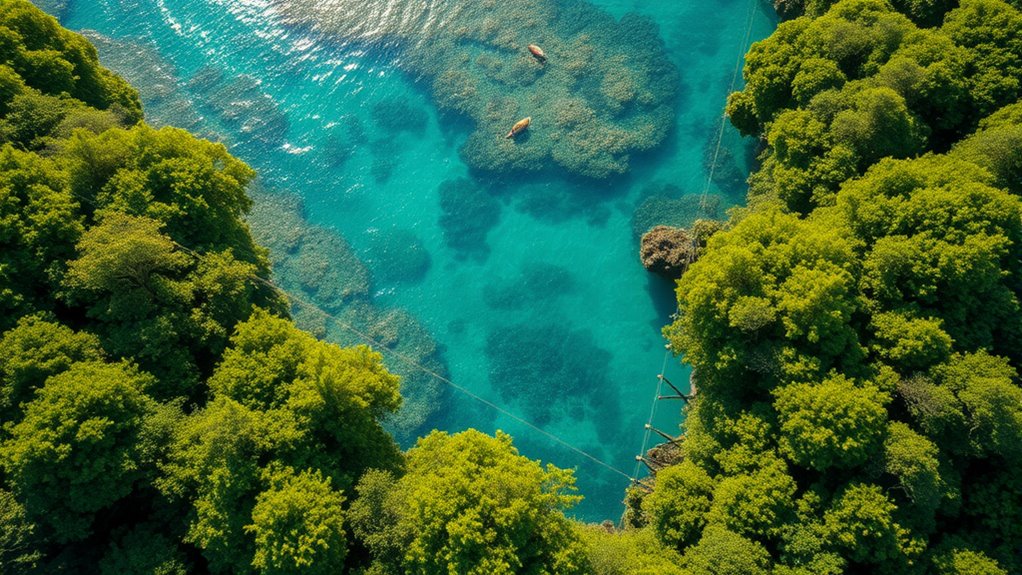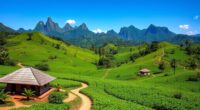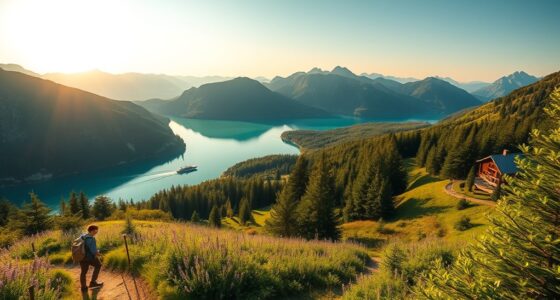New Zealand’s predator-free islands are part of an innovative effort to restore native ecosystems by eliminating invasive species like rats, stoats, and cats. These islands, such as Tiritiri Matangi and Kapiti, showcase successful eradication programs using advanced trapping, drone surveillance, and remote monitoring. As native birds and plants rebound, ecosystems become healthier and more resilient. To discover how these efforts are changing conservation, you will find fascinating details that highlight the future of ecological restoration.
Key Takeaways
- New Zealand has established predator-free islands like Tiritiri Matangi and Kapiti to protect native bird species.
- These islands utilize advanced eradication techniques, including drone surveillance and targeted trapping.
- Predator eradication on these islands has led to significant ecological recovery and increased biodiversity.
- Community involvement and volunteer efforts are essential for maintaining predator control measures.
- The success of predator-free islands serves as a global model for island and habitat restoration.
The History and Motivation Behind Predator Eradication
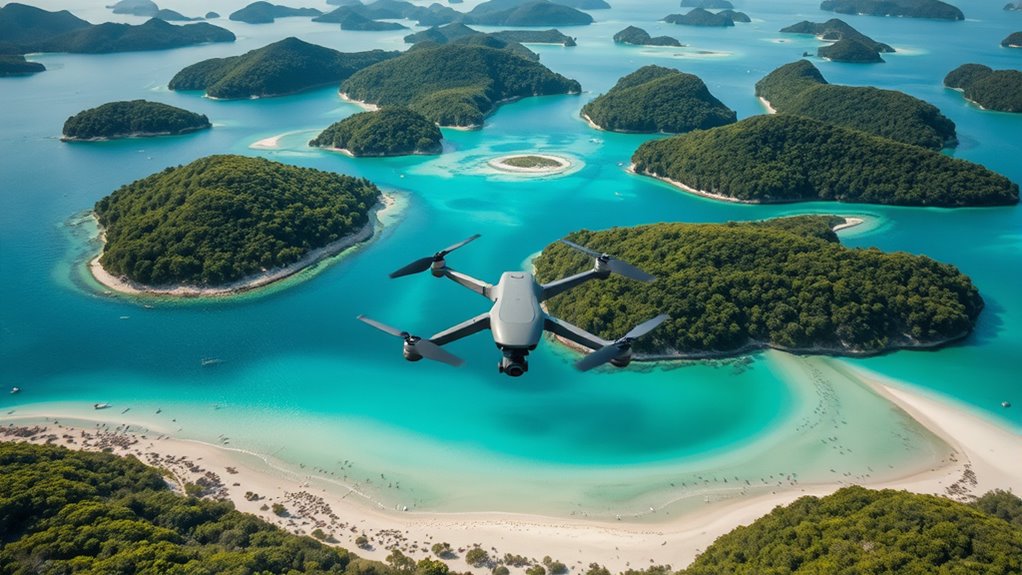
The drive to eradicate predators in New Zealand begins with the recognition that invasive species like rats, stoats, and cats have devastated native bird populations. These predators threaten the fragile balance of local ecosystems, making conservation efforts urgent. The motivation behind predator eradication centers on ecosystem restoration—reviving native plants and animals that have struggled to survive. By removing invasive species, you help create safer habitats for native birds and other wildlife. This effort isn’t just about saving individual species; it’s about restoring the health of entire ecosystems. The goal is to establish predator-free zones that support biodiversity and resilience. Over time, these conservation initiatives have gained momentum, driven by the understanding that eradicating predators is vital for New Zealand’s ecological recovery. High conservation value efforts are also supported by advanced tracking and eradication techniques that increase success rates.
Key Islands Leading the Conservation Effort
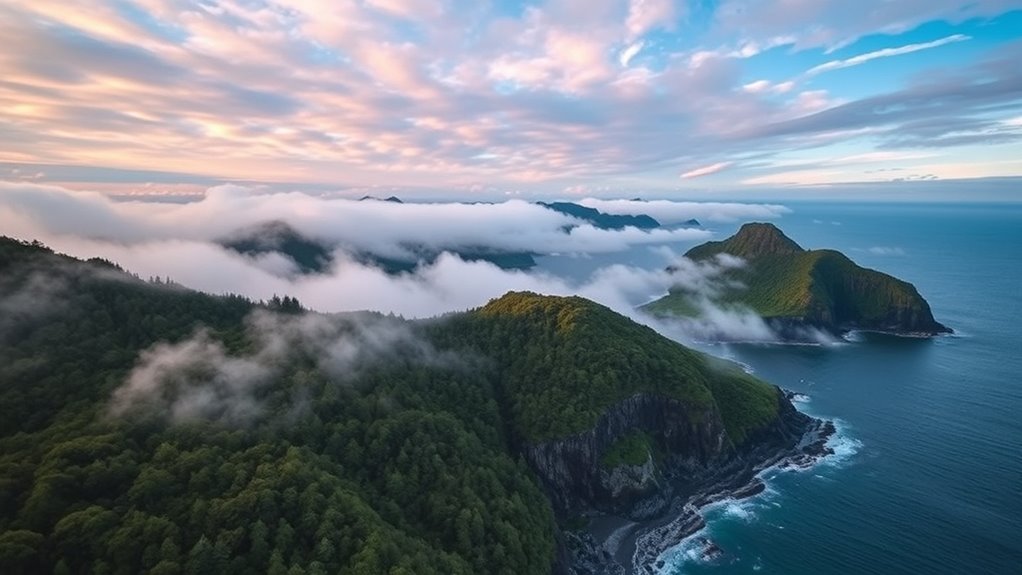
Several islands in New Zealand stand out as leaders in the predator-free movement, serving as models for successful conservation efforts. These islands have made remarkable progress in protecting native bird populations by eliminating invasive species like rats, stoats, and possums. For example, Tiritiri Matangi Island has become a sanctuary where native birds thrive, thanks to intensive predator control. Similarly, Kapiti Island demonstrates how focused eradication programs can restore ecosystems and boost native bird diversity. These islands show that targeted efforts can remove invasive predators effectively, giving native birds a chance to recover and reproduce safely. The use of self-watering plant pots in native plant nurseries is helping restore vegetation, which supports a healthy habitat for native birds. Your support for these initiatives helps maintain these successes and inspires other islands to join the predator-free movement across New Zealand.
Techniques and Technologies Used in Predator Control
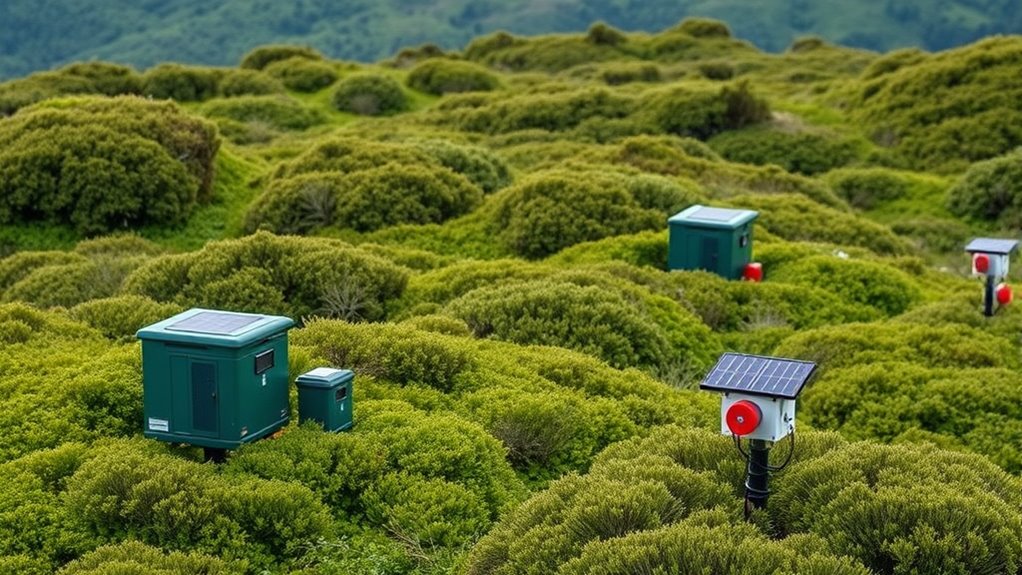
Advancements in techniques and technologies have revolutionized predator control efforts on New Zealand’s islands, making eradication more effective and efficient. You now rely on avian monitoring to track bird populations and detect predator presence, providing real-time data to guide actions. Drone surveillance has become a game-changer, enabling you to survey large areas quickly and accurately, identify predator hotspots, and deploy control measures precisely. These technologies reduce the need for manual patrols and allow for targeted removal of invasive species like rats and stoats. As a result, your efforts are more strategic, resource-efficient, and less invasive, increasing the likelihood of successful predator eradication. Utilizing high-efficiency solar panels can also enhance remote monitoring stations, ensuring continuous operation in the field. These innovations are vital for protecting native wildlife and restoring ecological balance on the islands.
Success Stories and Ecological Impacts
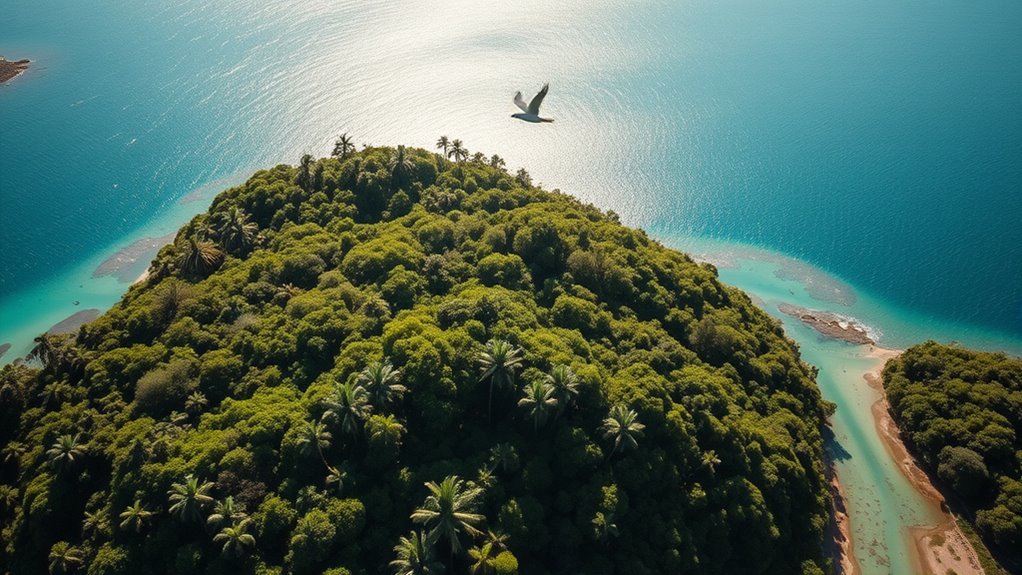
Thanks to these innovative control efforts, many islands have seen remarkable recoveries of native species and ecosystems. Native birds like kiwi and kokako are thriving once again, their populations rebounding thanks to predator eradication. These successes highlight how community engagement plays a crucial role; local residents, volunteers, and organizations work together, maintaining traps and monitoring progress. As a result, ecosystems become healthier, with plant life flourishing and biodiversity increasing. The ecological impacts are evident: predator-free islands now serve as essential refuges for vulnerable species. These success stories demonstrate that targeted predator control, combined with active community participation, can restore ecological balance. Regular monitoring and trap maintenance are key to sustaining these efforts and ensuring ongoing success. Your involvement and support are key to sustaining these positive outcomes and protecting New Zealand’s unique natural heritage.
Future Plans and Global Significance
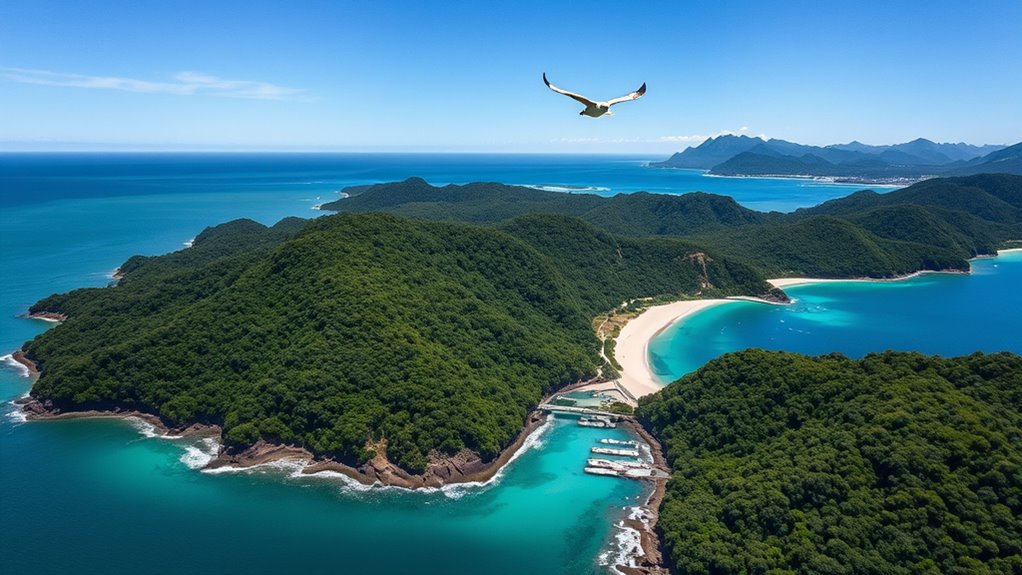
Building on the success of predator eradication on New Zealand’s islands, future plans aim to expand these efforts and strengthen ecological recovery. You’ll see initiatives like establishing new marine reserves that protect both land and sea ecosystems, ensuring broader conservation. Additionally, indigenous partnerships will play a crucial role, involving Māori communities in decision-making and restoration projects. Your involvement might include supporting local initiatives or promoting sustainable practices. The key goals include:
- Extending predator-free zones to mainland areas for a more extensive impact.
- Integrating marine reserves to safeguard marine biodiversity.
- Strengthening indigenous partnerships to honor cultural values and improve ecological outcomes.
Furthermore, adopting halal standards in project planning can promote inclusivity and respect for diverse cultural practices, fostering broader community support.
These efforts not only aim to restore New Zealand’s unique ecosystems but also set a global example for island and marine conservation.
Frequently Asked Questions
How Do Predators Affect Native New Zealand Species?
Predators threaten native New Zealand species by hunting them, disrupting their populations and ecosystems. Invasive species often outcompete or prey on native animals, causing declines or extinction. To protect these species, habitat restoration is vital, removing invasive predators and restoring natural environments. You can support predator control efforts, helping native wildlife thrive by reducing the impact of invasive species and creating safer habitats for them to reproduce and flourish.
What Challenges Are Faced in Maintaining Predator-Free Islands?
Think of maintaining predator-free islands as walking a tightrope. You face constant challenges in island biosecurity and invasive species management, needing vigilant monitoring to catch threats early. You must prevent predators from slipping through quarantine measures, control invasive species that threaten native wildlife, and manage human activity that could introduce new risks. Staying proactive and adaptive is essential, as even small breaches can undo years of conservation work and compromise the island’s delicate ecosystem.
How Is Community Involvement Incorporated Into Conservation Efforts?
You can be actively involved in conservation efforts through community engagement and volunteer programs. These initiatives encourage local residents and visitors to participate in activities like trapping, monitoring, and habitat restoration. Your involvement helps protect native species and maintain predator-free environments. By volunteering, you contribute directly to the success of conservation programs, making a tangible difference in preserving ecosystems for future generations. Your participation fosters a shared sense of responsibility and community pride.
Are Predator Eradication Methods Safe for Humans and Other Wildlife?
Imagine walking through a lush forest, unaware that invasive species threaten its delicate balance. Predator eradication methods are generally safe for humans and wildlife when carefully designed, but ethical considerations matter. You should know that many methods target invasive species, helping native wildlife thrive. While some techniques pose minimal risk, ongoing monitoring guarantees safety, making conservation efforts effective without harming ecosystems or people.
How Can Other Countries Adopt Similar Predator-Free Initiatives?
To adopt similar predator-free initiatives, you should focus on ecological restoration and policy integration. Start by evaluating local ecosystems to identify key predators and vulnerable species. Engage communities and policymakers to develop effective strategies, including targeted eradication methods. Securing funding and creating regulations will support long-term success. You need coordinated efforts that combine science, policy, and public support, ensuring sustainable predator control and healthier ecosystems.
Conclusion
By helping New Zealand turn its islands into predator-free havens, you become part of a movement that’s rewriting nature’s story. These efforts are like a lighthouse guiding us back to balance, showing that with determination and innovation, we can protect endangered species and restore ecosystems. Your support fuels this remarkable journey, proving that even small actions can make waves. Together, we’re forging a future where nature thrives, wild and free, on islands that stand as symbols of hope.

